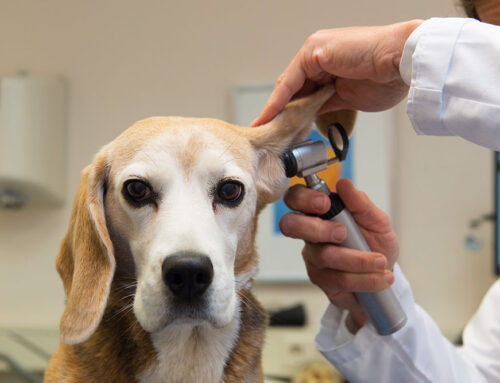Lumps and Bumps in Pets: When to Worry and What to Do
Finding a lump on your pet can be alarming, and it’s normal to have questions. Is it something serious? Should you watch it or have it looked at right away? At Palm City Animal Medical Center, we see masses, growths, and lumps every day- and we’re here to help you understand what’s normal, what’s not, and when to take action.
While some growths are harmless, others may point to infection, injury, or even underlying disease. The best approach is to have any new or changing lump evaluated, so you can make an informed decision about your pet’s care.
What Counts as a Lump or Bump?
“Lump” is a broad term that covers any abnormal swelling on or under your pet’s skin. Some feel soft and moveable, while others are firm and fixed in place. They may appear suddenly or grow slowly over time. Regardless of the type, any new or changing mass should be checked by a veterinarian.
Common Causes of Lumps in Pets
There are many reasons why a lump might appear on your pet. Some are completely benign, while others may require medical treatment.
Lipomas: These fatty tumors are usually soft, painless, and slow-growing. They’re most common in middle-aged and senior dogs. Learn more about lipomas.
Abscesses: Caused by bite wounds or punctures, abscesses are painful, inflamed swellings filled with pus. Cat abscesses are especially common in outdoor cats and can become serious if left untreated. A skipped meal or sudden limp in an outdoor cat is often a first sign that an abscess is brewing.
Warts and Skin Tags: Often harmless, these small growths can become irritated or infected, especially in high-friction areas or spots that can be easily scratched. Oral papillomas are a contagious, temporary “wart” that mostly affect dogs under the age of two. These papillomas may appear around a dog’s mouth or lips.
Hematomas: These fluid-filled swellings are caused by ruptured blood vessels, often after head shaking or ear trauma. Ear hematomas are a relatively common issue in dogs with very itchy ears or ear infection, and usually require drainage.
Hives: Raised, itchy welts caused by allergic reactions. Hives in dogs may appear suddenly and require antihistamines or supportive care.
Cysts: These fluid-filled sacs can swell or shrink over time. While most are benign, some may need to be drained or removed if they become infected or rupture.
Tick Bites: After a tick detaches (or is removed), a firm, small lump may remain due to localized inflammation- especially if part of the tick’s head is left behind. These should be monitored for signs of infection. Learn more about tick prevention to help reduce future issues.
Foxtails: These barbed plant awns can burrow under the skin, causing painful abscesses or inflammatory lumps. Foxtails can be especially dangerous when embedded in the paws, ears, or nose.
Elbow Calluses: Hard, thickened skin over bony areas can sometimes crack or develop secondary infections, resulting in swelling. These calluses are common in large-breed dogs and may improve with supportive bedding.
Neoplasia (Tumors): Any abnormal cell growth, including both benign and malignant tumors. This AAHA guide explains the types of cancer that can occur in pets. Common skin masses to watch for include squamous cell carcinoma, mast cell tumors, sebaceous adenomas, melanoma, and hemangioma. Learn more about cancer warning signs.
When to Be Concerned: Red Flags That Warrant a Vet Visit
Some lumps require prompt medical attention. Contact us if you notice:
- Rapid growth
- Pain or sensitivity to touch
- Bleeding, discharge, or ulceration
- Lumps around the throat, eyes, or joints
- Lethargy, appetite changes, or vomiting
- Weight loss or other systemic symptoms
These signs may indicate an abscess, infected cyst, or cancerous tumor. Early diagnosis often leads to better treatment outcomes.
What Happens at the Appointment?
When you bring your pet to Palm City Animal Medical Center, we begin with a physical exam to assess the lump’s size, shape, location, and mobility. Based on what we find, we may recommend:
- Fine Needle Aspiration (FNA): A simple technique to extract cells for analysis. Cytology helps determine whether a lump is inflammatory, infectious, or neoplastic.
- Biopsy: A small sample of tissue is surgically collected and sent to the lab for a definitive diagnosis.
- Bloodwork: To assess organ function or detect signs of infection or cancer spread.
- Imaging: X-rays or ultrasound can help evaluate internal masses or check for spread to lymph nodes or other organs.
Treatment Options for Lumps and Growths
Treatment depends on what we’re dealing with:
Benign Lumps:
- Monitor over time with regular measurements
- Surgical removal if they grow, become irritated, or impact mobility
Infections or Abscesses:
- Drainage and wound care
- Antibiotics or anti-inflammatories
Cancerous Masses:
- Surgery to remove the tumor
- Oncology consultation for chemo, radiation, or targeted therapy
- Palliative care if the focus is on comfort.
Monitoring at Home
Early detection often starts with you. Run your hands over your pet’s body during brushing or bath time, and keep track of any changes you find.
At-home monitoring tips:
- Measure lumps and take photos monthly
- Watch for changes in texture, pain, or discharge
- Let us know if anything new appears- or an old lump changes
Your Partners in Pet Health
Lumps and bumps are a part of life for many pets, but they’re not something to ignore. At Palm City Animal Medical Center, we’re here to help you sort out the harmless from the serious, so you can take action with confidence. We offer full in-house diagnostics, personalized treatment plans, and supportive care every step of the way.
If you’ve noticed a new lump, or you’re just not sure what you’re feeling, contact us. Early evaluation can bring clarity and peace of mind.









Leave A Comment